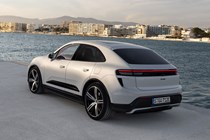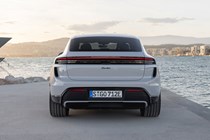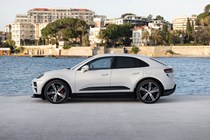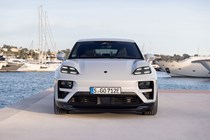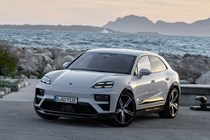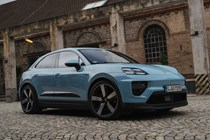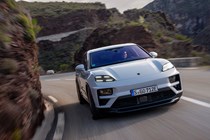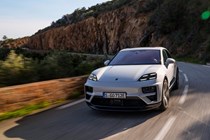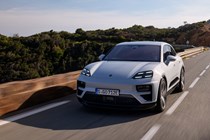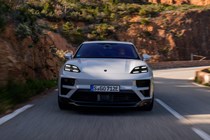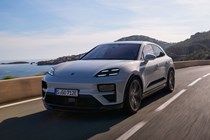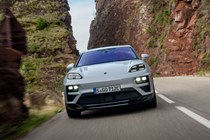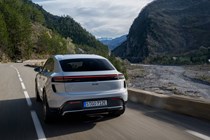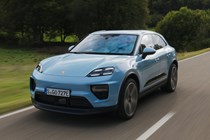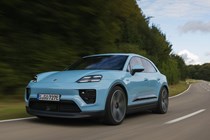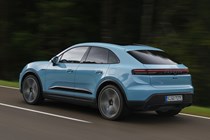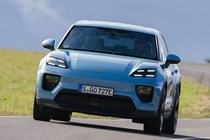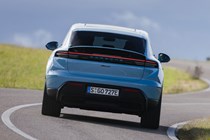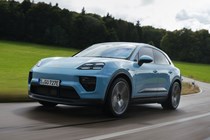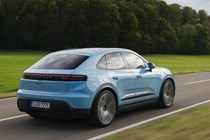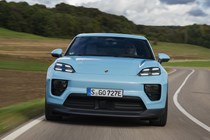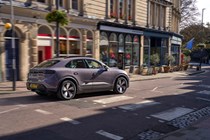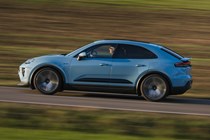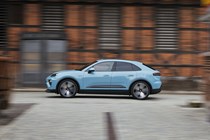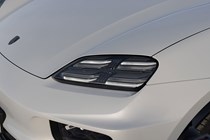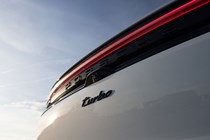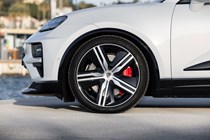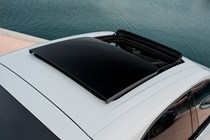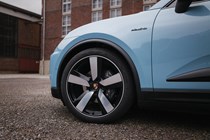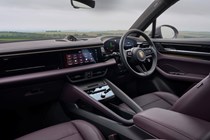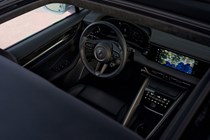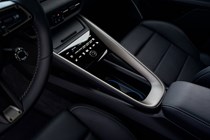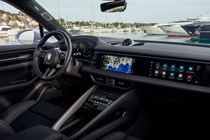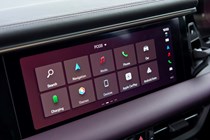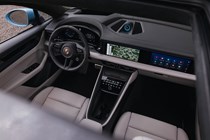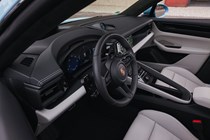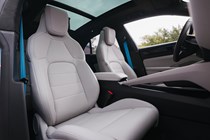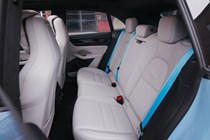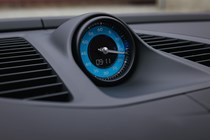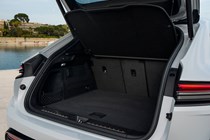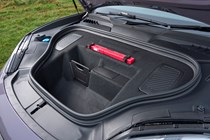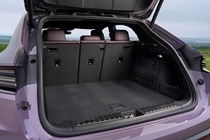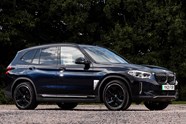
Porsche Macan review
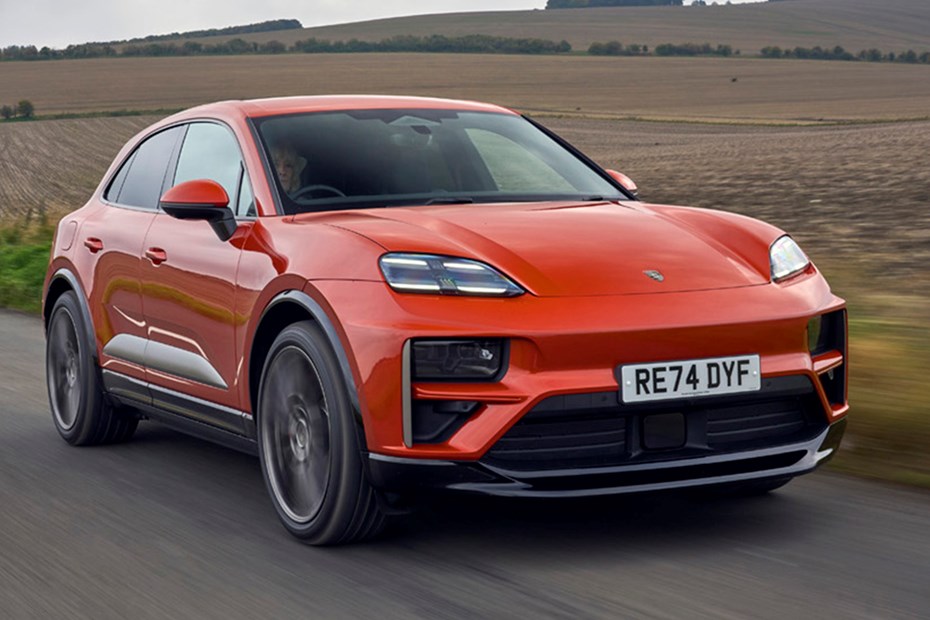
At a glance
| Price new | £68,565 - £96,965 |
|---|---|
| Used prices | £57,084 - £92,730 |
| Road tax cost | £620 |
| Insurance group | 44 - 50 |
Get an insurance quote with

|
|
| Fuel economy | 2.9 - 3.8 miles/kWh |
| Range | 318 - 398 miles |
| Miles per pound | 4.6 - 11.2 |
| Number of doors | 5 |
| View full specs for a specific version | |
Available fuel types
Fully electric
Pros & cons
- Lovely steering system
- Good range and charging ability
- Comfortable ride on 20s
- Sport Plus mode too stiff
- Coupe shape eats into boot space
- Expensive options jack up price
Porsche Macan SUV rivals
Overview
This is the all-new Porsche Macan – and it’s more of a gamble than first appearances would suggest. Stuttgart has flipped the car on its head for its second generation by ditching petrol power completely and turning it into an electric SUV.
That presents a problem. Since the start of 2024, electric car sales have been stagnating, which doesn’t bode well for the Macan’s sales record. The previous model was Porsche’s best-selling car globally, with more 850,000 examples finding homes since it was launched in 2014.
The question is, does this new Macan retain enough of the old car’s qualities to encourage buyers to overlook their electric car prejudices and make the switch to an EV? Or is Porsche about to break the Macan’s outstanding sales streak? You can read more about how we test cars at Parkers, but in the meantime, scroll down to find out how the brand has done.

What’s it like inside?
It’s a good start because, even though the Macan is built on the same platform as the Audi Q6 E-Tron, you’d never tell from inside. It’s quintessentially Porsche, sharing the same skinny steering wheel and high-quality switchgear as the Taycan and 911.
However, if you want to make your Macan look like the cars in these images, you’ll need to make merry with the Porsche configurator – and therein only financial ruin lies. It’s very easy to get carried away with options and spend more than you’d like. The Macan 4 we tried on the launch event was fitted with almost £25,000 worth of additional kit.
As standard, you get a 12.6-inch curved digital gauge cluster and a 10.9-inch central display. Both are razor-sharp and easy to use. Plus, the latter screen isn’t overbearing like it is on the Mercedes EQA because it’s housed within the dash, rather than being proud of it. You also get physical climate controls, unlike on a Merc EV. We like that.
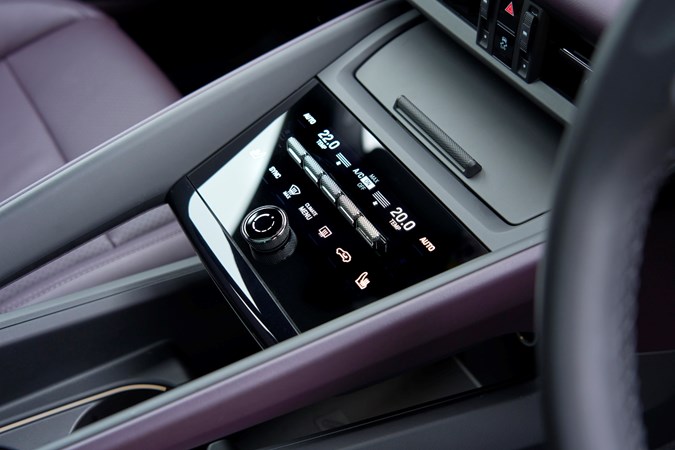
Spend another £1,112 and you can have a 10.9-inch screen for the passenger side of the dashboard. Cleverly, it’s fitted with a polarising filter that prevents the driver from seeing the content it’s displaying, so the passenger can watch films as you drive along.
The wheelbase is 86mm longer than the previous Macan so rear legroom is improved. Headroom is adequate in the back – a six-footer is fine – but if you regularly carry tall passengers you might want to opt for the panoramic glass sunroof as that yields a bit more head space. The front seat drops nice and low (28mm lower than the ICE Macan), which gives you the feeling you’re sat in a sports car.
It’s also got a bigger boot than the last Macan that is supplemented by an 84-litre frunk and plenty of storage in the cabin thanks to the space efficiencies of batteries. But beware of carrying large, square items as the coupe-like shape of the Macan’s back end means that the boot is a bit pinched for tall items.
Safety
The Macan has LED headlights as standard, while the Turbo gets upgraded LED Matrix lights that can intelligently pick out oncoming traffic and blank out the respective LEDs. Incidentally, the top headlight with the distinctive four bars is the daylight running light – the lower unit in the bumper is the one that generates the light you’ll see with at night.
The usual plethora of safety systems are included as standard, including a speed detector that bongs gently if you exceed the limit, but this and the lane keep assist can be turned off within a sub menu in the touchscreen. Not ideal, but these are the rules we’re all operating to these days.
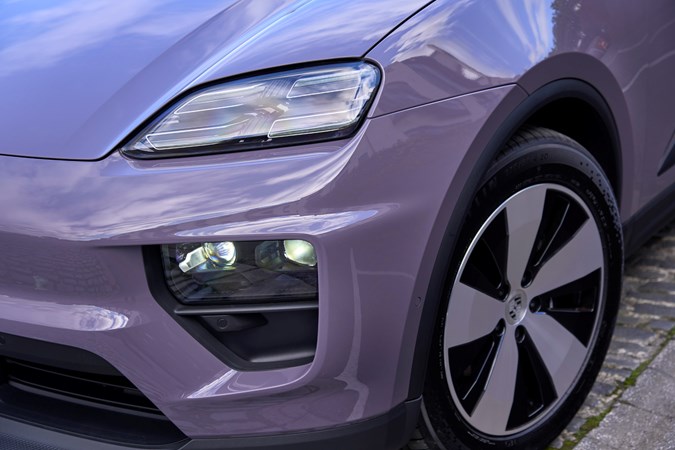
New to this generation of Macan is augmented reality nav, which is an optional extra that features as part of the head-up display. This is now projected further ahead, so your eyes don’t need to adjust their focal length quite as much switching between the road and the display. It works well but is expensive at £1,694.
Comfort
On its standard 20-inch alloys and simplest coil spring suspension, the Macan’s ride comfort is impressive. It’s settled at Autobahn speeds and compliant around town – and the thicker tyres round off the initial edge of jolts.
We weren’t exactly bowled over by the Macan’s air suspension when we first got behind the wheel, but subsequent tests in the UK were much more positive. The smaller, 20-inch wheels are still king for ride quality, but the air-sprung Turbo on 22s on British roads was still a relaxing place to be with good isolation from all but the worst surfaces.

If you want to firm things up, you can make your Macan especially uncomfortable by engaging the Sport Plus driving mode. However, we’d say this is unnecessary unless you’re on a super-smooth race track – which is unlikely given this car’s target market. Leave it in the regular settings and you’ve still got strong body control and agility.
Electric motors
There are four versions of the new Macan to choose from – and we’ve tried them all. The range starts with the most basic, self-titled Macan, before ascending to the Macan 4, Macan 4S and the lightning bolt-chucking Macan Turbo.
Having now spent an afternoon with the billy basic, rear-wheel drive Macan, though, we’re struggling to see why anyone would pine for the extra performance of the more expensive models. It’s hardly slow – it has 360hp and 563Nm of torque, which is enough for a 0–62mph time of 5.7 seconds.
And yes, before you all write in to criticise our judgement, we know that’s a second slower from a standstill than the Volkswagen Golf R. But the Macan doesn’t feel that much lardier once you’re up to speed because all 360hp is available the moment you mat the accelerator. There’s no turbo lag to slow you down, here.
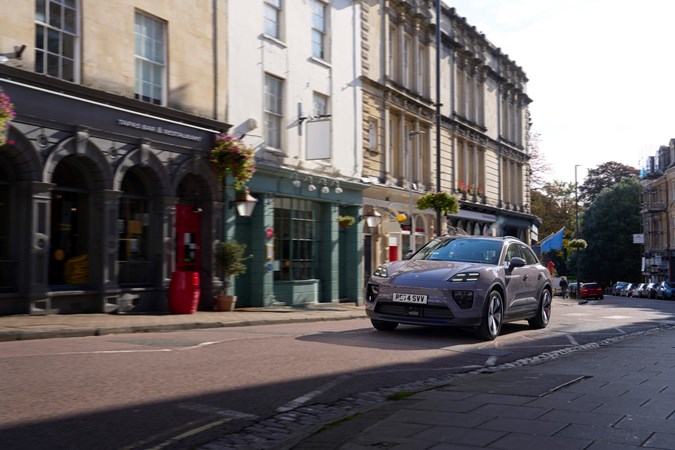
The Macan 4 is a bit punchier. You get an extra motor on the front axle which boosts output to 408hp and 650Nm of torque – and that, in turn, hacks the car’s 0–62mph time down to 5.2 seconds. If we’re honest, such a minor jump in performance isn’t worth the extra money.
But the Macan 4S is a completely different box of frogs. It also has two motors, but the rear one is longer and girthier. If you’re chasing massive performance from your EV, bigger is better. Maximum output soars to 516hp and 820Nm of torque, trimming the car’s 0–62mph time down to 4.1 seconds. That’s frightening in a 2.3-tonne SUV.
If you’re still not satisfied, though, there’s always the Macan Turbo. It has 639hp and frankly preposterous 1,130Nm of torque. The result? It’ll do 0–62mph in 3.3 seconds. That’s the same as an Audi R8. We advise you to exercise caution, though. As we’ll explain below, the Turbo doesn’t feel as natural as its lesser-powered siblings.
What’s it like to drive?
That depends entirely on the specification of your car and, as is so often the case with Porsches, basic is best. We’ve now tried cars on both steel and air suspension, and we can confirm the former option is the way to go (unless you’re looking for some extra bragging rights to bore your mates with down the pub).
The air-sprung Macan is far more nervous and fidgety than the conventionally spung model. We tried both cars back-to-back on Germany’s meticulously maintained roads, and the body on the fancier model was constantly jostling over ruts the standard car couldn’t find. It’s even more noticeable when you engage Sport Plus mode – and it means the Macan can be quite unnerving to drive quickly.
That’s a shame, because the rest of the new Macan is properly sorted. We’re not going to pretend it’s anywhere near as engaging as 718 Cayman or a 911 Carrera but, for an SUV that weighs 2.2 tonnes in its lightest trim, it puts on a great show. It’s way better than a Tesla Model Y or an Audi Q6 E-Tron.
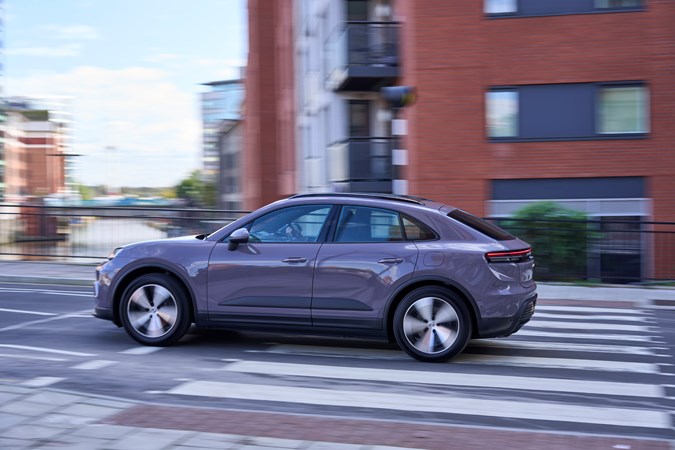
We love its steering, too. It isn’t exactly overflowing with feedback when you compare it to the rest of Porsche’s cars, but it’s comfortably the sharpest and most direct in its class. The brakes deserve a special mention, too – Porsche has masterfully tuned the changeover from regenerative to friction braking. The pedal feels utterly natural.
The rear-driven model feels so much more balanced and composed. When we were pedalling the 4S around the twisty mountain roads on the outskirts of Stuttgart, the body constantly felt like it was battling the chassis, and its tyres were screaming in protest at just 40mph – but the standard Macan cornered keenly and kept quiet.
If a little bit of unruliness doesn’t faze you, you’ll appreciate the extra poke from the Turbo. Plus, it also comes with four-wheel steer which means it’s possible to carry frankly bonkers level of speed into corners.
However, that system finds lumps in the tarmac that the front end seems to miss entirely, which feels a little disjointed if you’re used to driving simpler fast petrol cars. You’d get used to it, but the Macan feels more instantly at ease with fewer quirks. If you’re looking for a posh family car, stick with the standard model.
What else should I know?
This is a huge step forward for the Macan but, if you can’t make an EV fit into your lifestyle, you’ll still be able to buy a petrol-powered Macan until the end of 2025. And to give you an idea of how important the UK market is to Porsche, the petrol Macan was pulled from its European showrooms in July 2024 due to new EU legislation.
We’d like to stress just how careful you need to be with Porsche’s configurator. The level of customisation is almost endless – there are 72 different paint finishes and 14 unique interior upholstery finishes, all of which will carve chunks out of your bank account. You can easily spend more than £120,000 on one.
Now click through to the next page for our final verdict on the new Porsche Macan.



